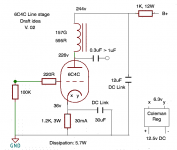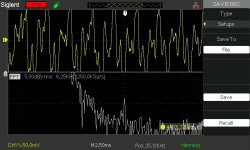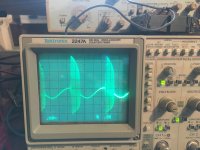25k bump in fft?
Wondering if my tinnitus (not always constant) could be caused by an oscillation I used my siglent scope (very new to me) to see if anything could be going on.
I noticed in the fft there is a bump around 25K. This image was taken while spinning vinyl, but noticed the bump (more pronounced) when I lifted the needle... Is this an artifact or something I should dig into ? If so, where would you start ?
Wondering if my tinnitus (not always constant) could be caused by an oscillation I used my siglent scope (very new to me) to see if anything could be going on.
I noticed in the fft there is a bump around 25K. This image was taken while spinning vinyl, but noticed the bump (more pronounced) when I lifted the needle... Is this an artifact or something I should dig into ? If so, where would you start ?
Attachments
If you disconnect the turntable does it still do it? if you ground the input, does it still do it?
Do you have any gear near the turntable or wiring that uses a switching power supply? If the audio system grounded to building ground?
25kHz shouldn't just come out of nowhere. Chances are you have an oscillation that might be solved with a larger grid stopper, or better cabling. I had a phono stage that picked up FM radio once. I could clearly hear 99.9MHz through it. Different tubes didn't do this.
Lots of places to check anyway.
Do you have any gear near the turntable or wiring that uses a switching power supply? If the audio system grounded to building ground?
25kHz shouldn't just come out of nowhere. Chances are you have an oscillation that might be solved with a larger grid stopper, or better cabling. I had a phono stage that picked up FM radio once. I could clearly hear 99.9MHz through it. Different tubes didn't do this.
Lots of places to check anyway.
Last edited:
Turn off the power amp and disconnect everything from the input, if it is a separate power amp, and put a shorting plug in the audio input.
If it is an integrated amp, short the preamp input. See if it still has an AC waveform.
Is it there without the shorting plug?
Is it there when the preamp is added back into the mix? Is it affected by the volume control or tone controls?
If it is an integrated amp, short the preamp input. See if it still has an AC waveform.
Is it there without the shorting plug?
Is it there when the preamp is added back into the mix? Is it affected by the volume control or tone controls?
Wondering if my tinnitus (not always constant) could be caused by an oscillation I used my siglent scope (very new to me) to see if anything could be going on.
I noticed in the fft there is a bump around 25K. This image was taken while spinning vinyl, but noticed the bump (more pronounced) when I lifted the needle... Is this an artifact or something I should dig into ? If so, where would you start ?
This is a very interesting question. Maybe my answer is slightly off-track, but the valid question is - do we hear super-sonic oscillations?
I have T for 40 years (firecrackers) - and when the music is awkward it gets - - worse. What is first, second? Is there a causal relation I have oft wondered.
Well my wife had an accident, some time ago, and now she told me about her having T, and dizzying sounds. That starts or gets worse with harshness in the sound. She is a very sensitive weather vane recently, a bit annoying though as I tend to cater for her taste.
Last night she showed me how a cable (premium Isoda cable) sounded harsh. Before she had said my 100 nF large mica’s coupling caps were giving too much high frequency noice. I noticed too, different less pleasing balance than PIO. She hears less difference normally but though she does not understand she can give good comments.
And I once noted a slight tendency of a studio monitor to peak at 22kHz, never exited in the measurements, but I could here the interference it gave with tracks. The maker of the line of monitors agreed with me. They had taken the monitors outside just to check.
This is a very interesting question. Maybe my answer is slightly off-track, but the valid question is - do we hear super-sonic oscillations?
I have T for 40 years (firecrackers) - and when the music is awkward it gets - - worse. What is first, second? Is there a causal relation I have oft wondered.
Only when we are reincarnated as a bat. But then we gotta eat bugs. So think I'll pass on the Ultrasound.😀
I have T for 40 years (firecrackers) - and when the music is awkward it gets - - worse. What is first, second? Is there a causal relation I have oft wondered.
Only when we are reincarnated as a bat. But then we gotta eat bugs. So think I'll pass on the Ultrasound.😀
Last edited:
I deal with my tinnitus by sleeping with the television on. Music doesn't seem to effect it, and it always basically sounds like a CRT monitor with a baffed horizontal drive. ~14.5kHz It only really annoys me in quiet settings.
My tinnitus goes up and down. Not at a constant level. I have a couple of class D amplifiers that sound really horrible to me on “bad tinnitus” days, and not so bad when the ringing is less. Nearest I can figure is that the ultrasonic garbage is mixing with the tinnitus. I had a class AB amp oscillating at 50kHz when the fluorescent lights are on that would just sound so BRIGHT when it was doing it that it would drive me from the room. Probably the oscillation mixing with high order harmonics, and also probably the ringing in my right ear. Far worse than the left most days.
Just today I took in an original, pristine condition Fender Pro Reverb made in 1965, for a problem that presented as both low volume and a "Broken speaker" type of rattling distortion. After checking the speakers and the tubes and finding no problems with any of them, I took the chassis out of the cabinet, set it up on my test bench, and began investigating the nature of the anomaly. What I found is that the distorting sound was a parasitic at 134 KHz that was triggered for roughly 40 cycles every time the input level reached a specific threshold voltage. (Top of the input sine wave, when using a signal generator as the source.)
It's nice that I can measure the frequency of a signal using my scope, and I wasn't content just to see the unusual signal, of course I had to characterize it.
But what was the source of it?
As I was probing the circuit and moving my probe ground clip to various grounds as needed, I found the loose ground wire that had come free from its solder bead on the brass grounding plate behind the tone controls.
Resoldering the ground securely fixed the problem.
It wasn't 10 minutes of bench time to investigate the problem, find the cause, and effect the repair. My customer is thrilled, of course.
I was actually a bit disappointed, because I really get into the troubleshooting process. I was just getting warmed up when I found the problem. I was looking forward to a more involved snipe hunt.
It's nice that I can measure the frequency of a signal using my scope, and I wasn't content just to see the unusual signal, of course I had to characterize it.
But what was the source of it?
As I was probing the circuit and moving my probe ground clip to various grounds as needed, I found the loose ground wire that had come free from its solder bead on the brass grounding plate behind the tone controls.
Resoldering the ground securely fixed the problem.
It wasn't 10 minutes of bench time to investigate the problem, find the cause, and effect the repair. My customer is thrilled, of course.
I was actually a bit disappointed, because I really get into the troubleshooting process. I was just getting warmed up when I found the problem. I was looking forward to a more involved snipe hunt.
Tube amp can also be compensated with miller cap. The principle that works on solid state also works on the tube.
The other option available is shunt compensation, however, it along is not effective or adequate. It normally works together with miller compensation.
The other option available is shunt compensation, however, it along is not effective or adequate. It normally works together with miller compensation.
Not sure if this will show. This is the oscillation that was observed in the amp described above.
That oscillation will cause a little DC- shift of the working point of the stage which is oscillating. When it stops oscillating the working point goes back to its original point. Perhaps that may cause the rattle?
The rattle is caused by it breaking in and out of oscillation. Every burst causes a single ‘tick’ sound, and when you string them together it sounds like a rattle. Been there done that bought the T shirt.
Tubes often have a region of gain expansion, where the gm is reaching its highest value somewhere as it is approaching vg1=0. Combined gm of a push pull pair can also reach a local maximum just a few volts off the quiescent point too. Depends on the plate characteristic and bias. If the increase in gm is enough to make it unstable, Houston you have a problem. If this is happening, it is marginally stable (and at risk) even when backed off or with no signal.
Tubes often have a region of gain expansion, where the gm is reaching its highest value somewhere as it is approaching vg1=0. Combined gm of a push pull pair can also reach a local maximum just a few volts off the quiescent point too. Depends on the plate characteristic and bias. If the increase in gm is enough to make it unstable, Houston you have a problem. If this is happening, it is marginally stable (and at risk) even when backed off or with no signal.
zobel networks
In some cases it is a good practice to use Zobel networks (RC) to make an amplifier unconditional stable. Those networks can be placed across the primary/secondary of the OPT and also between stages in series with coupling cap,etc. Generally when an OPT has not enough bandwith (mostly HFR) it is more likely the amp to oscillate when GNFB is applied. Those networks can be calculated from some emperical formulas but also can be determined with trial an error. As a rule of thumb a resistor equal to the primary impedance of the transformer in series with a small plastic cap is a good starting point to experiment. The value of the cap can be also calculated from a formula that i dont remember but i will provide when i look up my notes.I've been thinking recently (the past few years) that it makes a lot of sense to put an RC damper on the secondary of the OT. Just to provide some reasonable HF load rather than the pure (more or less) inductance from the tweeter or whatever driver.
Have not tried it. Surprised that this is not seen more in tube amps. I have only seen a few commercial designs where it is done.
Pete B.
cmjohnson's Post # 228 told the cause of the oscillation:
It was a ground connection that came loose.
Just to make it clear . . .
The lack of negative feedback compensation did not cause the oscillation.
The lack of a Zobel network did not cause the oscillation.
It was a ground connection that came loose.
Just to make it clear . . .
The lack of negative feedback compensation did not cause the oscillation.
The lack of a Zobel network did not cause the oscillation.
I may be getting oscillation so I'm trying a post here to see if it strikes a chord.

I have a tiny regular tapping noise at 53 BPM in my preamp. Looking for suggestions before I start pulling it apart. It's not the power supply - or I don't think so - because that's external and 2 different ones give the same result. I attach the schematic.
Ideas please!

I have a tiny regular tapping noise at 53 BPM in my preamp. Looking for suggestions before I start pulling it apart. It's not the power supply - or I don't think so - because that's external and 2 different ones give the same result. I attach the schematic.
Ideas please!
Choke too near to the triode? It should probably be 150mm (6") away, or a little more.
Grid wiring too long, or too near anode wiring?
Grid wiring too long, or too near anode wiring?
Choke too near to the triode? It should probably be 150mm (6") away, or a little more.
Grid wiring too long, or too near anode wiring?
I can check and adjust that. You mean the plate choke should be 6" away from the triode? I never thought of that.
It's not a grid stopper which is too small? The fact that it's regular - I imagine - means it's not a poor contact, since that's more crackly and irregular, or is it? I also wonder about the contacts in the valve base, which for the 6C4C is one of those large oval ceramic Chinese ones.
I haven't started looking yet.
A single stage by itself generally won’t oscillate. Are you connecting two channels to a common power supply? 1k and 12uF isn’t a whole heck of a lot of LF decoupling. If you're running two channels disconnect one and see if it stops. If it’s a problem with layout parasitics, you would get a high frequency oscillation (well above audio). Might want to scope it to see if the “53BPM“ is a low frequency oscillation, or high frequency bursts, about a second apart. The latter would be more common with multistage amplifiers with global feedback but it won’t hurt to rule it out.
I don't use a scope unfortunately - must teach myself how to use one. The taps are around 1K I'm guessing, and typically 53 beats per minute though it can vary and sometimes it's louder, sometimes it almost stops. But the taps are rather quiet, though clearly audible. I've tried 2 different external PSUs which are CLCRC with RC additionally in the preamp chassis. It's a single stage with its own PSU, R and L from same supply. No global feedback. I don't have a resistor to ground at the output like 1M or so, if that's a factor.A single stage by itself generally won’t oscillate. Are you connecting two channels to a common power supply? 1k and 12uF isn’t a whole heck of a lot of LF decoupling. If you're running two channels disconnect one and see if it stops. If it’s a problem with layout parasitics, you would get a high frequency oscillation (well above audio). Might want to scope it to see if the “53BPM“ is a low frequency oscillation, or high frequency bursts, about a second apart. The latter would be more common with multistage amplifiers with global feedback but it won’t hurt to rule it out.
- Home
- Amplifiers
- Tubes / Valves
- Oscillation in tube amps

